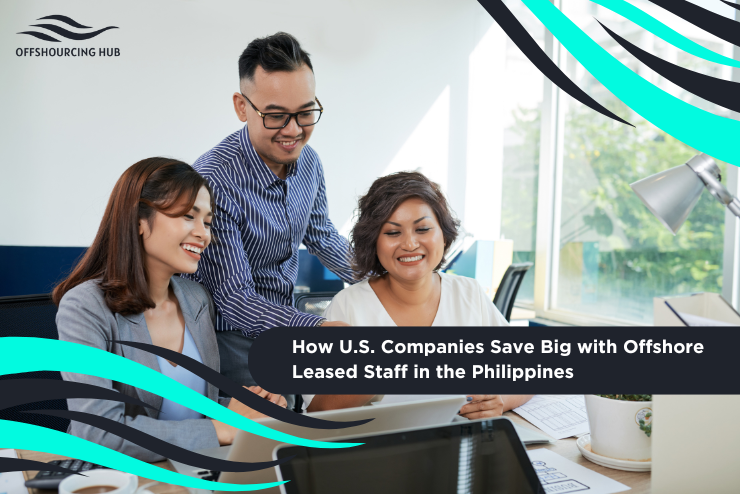How U.S. Companies Save Big with Offshore Leased Staff in the Philippines
- Sebastian Elliot Osborne

- Sep 5, 2025
- 5 min read

In the United States have reached levels that put enormous pressure on companies of all sizes. The Bureau of Labor Statistics reported in 2023 that the average employer spends nearly 30% of total compensation on benefits alone, on top of rising base salaries. For many business owners, this combination makes it difficult to grow teams without sacrificing profit margins. Skilled professionals are also in short supply, which drives wages even higher and leaves companies competing fiercely for talent.
I have seen this pattern repeatedly while working with businesses that explore offshore leased staff as a solution. Managers want to grow but feel trapped by the cost of hiring locally. What they often do not realize is that there is a proven and sustainable alternative: building teams through offshore leased staff in the Philippines. For more than a decade, the Philippines has built a reputation as a trusted source of skilled, English-speaking professionals who deliver high-quality work at a fraction of U.S. costs.
This is not about cutting corners. It is about reallocating resources in a smarter way. Companies that shift roles offshore often find themselves with the financial flexibility to reinvest in technology, expand services, and ease the workload on their onshore teams. Offshore leased staff in the Philippines provide a long-term solution that addresses both the cost of labor and the shortage of skilled professionals in the U.S. market.
In this article, we will break down the financial advantages U.S. businesses achieve with offshore leased staff, look at the challenges this model solves, and show how companies can implement it effectively for long-term growth.
The Financial Upside of Offshore Leased Staff

Major Payroll Savings
An accountant earning $70,000 a year in the U.S. can often be hired in the Philippines for less than half that amount. When a business looks at building a team of five or ten, the savings multiply quickly. This is not about cutting corners—it is about freeing money that would otherwise be locked into salaries. That same capital can be reinvested into client acquisition, software upgrades, or developing new services that generate higher revenue. With talent sourcing philippines, companies gain access to skilled professionals at a fraction of the cost.
Lower Overhead Costs
Expenses beyond wages also shrink. U.S. companies spend thousands on office space, equipment, and utilities. With offshore leased staff, the provider in the Philippines supplies these resources. The difference shows up in cash flow. Businesses see more money staying in their accounts each month instead of being swallowed by fixed costs.
No Burden of U.S. Benefits
Employers in the U.S. carry healthcare, retirement contributions, and insurance. In the Philippines, those expenses are either minimal or managed directly by the leasing firm. For U.S. businesses, this means a significant reduction in recurring costs without compromising the support employees receive.
Recruitment, HR, and Compliance Covered
Another advantage is time saved. Recruitment, payroll, and compliance are handled by the leasing provider. U.S. managers no longer spend weeks searching for candidates or managing HR processes. Instead, they focus on performance, client needs, and business development.
The Cost Challenges Facing U.S. Companies

Inflated Labor Costs
For many businesses, labor costs are their largest expense. When payroll, benefits, and taxes rise each year, profit margins shrink. Even companies with strong sales can feel pressure when too much revenue is consumed by overhead.
High Employee Turnover
High turnover adds another layer of cost, forcing managers to spend more on recruitment and training. Replacing staff is not just about money—it disrupts teams and slows down progress on projects.
Growth Restrictions
Growth plans stall when leadership is constantly fighting fires with staffing. Too much capital tied up in overhead means less room for technology investment, expansion, or improving client services.
How Offshore Leasing Solves the Cost Burden

A Cost-Effective Staffing Model
Offshore leased staff in the Philippines directly address those financial pressures. A U.S. company chooses the staff it needs, the leasing provider manages HR, payroll, and compliance, and the business maintains day-to-day oversight of the work. This creates stability without the usual hiring costs.
Businesses Retain Control
Even though the staff are offshore, U.S. companies keep control over their daily work. Managers set expectations, track performance, and ensure standards are met, while the leasing firm takes care of the employment logistics.
Skilled, English-Speaking Workforce
What makes the Philippines stand out is its workforce. Employees are skilled, English-speaking, and culturally aligned with U.S. operations. Many have worked with American clients before and understand expectations. This not only reduces the risk of miscommunication and ensures productivity from the start but also strengthens quality assurance in offshore teams, giving businesses confidence that tasks are done right the first time.
Putting Offshore Teams into Practice

Start Small with a Pilot Team
Getting started does not require a massive shift. Many U.S. firms begin with a small team handling accounting, customer support, or IT. Once the model proves its value, scaling becomes easier. From my experience working with Australian businesses, I’ve seen that starting small builds confidence—leaders quickly realize offshore staff aren’t just affordable, they deliver work with the same professionalism as onshore teams. That early success sets the tone for expansion.
Choose a Trusted Leasing Provider
Partnering with a reliable leasing provider is essential. They handle compliance, provide the workspace, and support staff. This gives U.S. companies confidence that operations are running smoothly. I’ve worked with firms that underestimated this step and ran into frustrations with poorly managed providers. Choosing the right partner makes the difference between saving money on paper and actually creating a sustainable offshore setup.
Scale Gradually
Growth can be paced according to business need. A company may keep core strategy and client-facing roles onshore while expanding support and technical roles offshore. This balance creates flexibility and resilience. I’ve seen businesses grow faster offshore than they first expected, but those who paced themselves carefully maintained better staff retention and smoother transitions across both teams.
Reinvest the Savings
The money saved by building offshore capacity can then be redirected into areas that help the business grow—upgrading systems, offering better client service, or opening new revenue streams. From my perspective, the companies that get the most long-term value from offshoring are those that treat the savings as fuel for growth rather than just a way to cut costs. It’s about building a cycle where efficiency offshore supports expansion onshore.
Your Offshourcing Advice

Offshore leased staff in the Philippines give U.S. businesses more than cost savings—they provide breathing room in a market where labor costs are at record highs. By reducing payroll expenses, eliminating the need for costly benefits, and shifting compliance and HR burdens to a trusted leasing provider, companies can create a leaner, more flexible operating model. This allows business leaders to stop worrying about overhead and start focusing on growth. Many firms that adopt this approach discover they can expand services, invest in client relationships, and improve retention among their local teams because workloads are better balanced.
Looking ahead, offshoring in the Philippines is becoming less of a short-term cost-cutting tactic and more of a long-term strategy for sustainability. With the country offering a large pool of skilled, English-speaking professionals who understand Western business culture, U.S. companies gain access to talent that supports both day-to-day operations and future expansion. Offshore leased staff create a path for businesses to stay competitive, adapt to economic pressures, and reinvest where it matters most—ensuring growth is not only possible but sustainable in an increasingly challenging labor market.





Comments